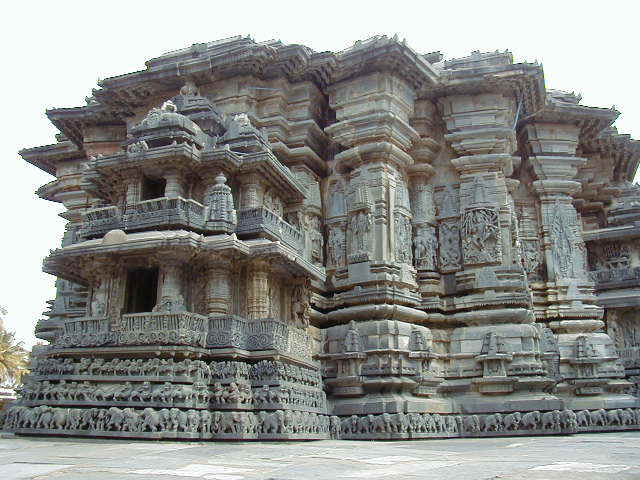|
|
Belur Chennakesava Temple

Name of the Temple |
- The Chennakeśhava Temple, originally known as the Vijayanārāyaṇa
|
Location |
- Temple was built on the banks of the Yagachi River in Belūr, Karnataka, South India
|
| How to reach there? |
- By Air: The nearest airports are Bengalūru (222 km) and Mangaḷūru (194 km). From Bengalūru airport take the National Highway 73 west. From Mangaḷūru take the National Highway 73 east.
- By Train: The nearest railway station is located in Hassan, 40 km away. From there take the State Highway 57 north to reach Bélūr.
- By Road: One can reach Bélūr from Hāsan, located 40 km away.Bélūr is connected by the National Highway 73 to Bengalūru and Mangaḷūru.
|
Rulers/builders and Time Period |
- The temple was commissioned by Hoysaḷa King Viṣhṇuvardhana in 1117 CE.
- The main temple is Chennakeśhava and it also has smaller temples of Kappe Chennigarāya, Saumyanāyaki, Vīranārāyaṇa, Raṅganāyaki and Ānjaneya in its surroundings.
- A total of 118 inscriptions have been recovered from the temple complex covering a period of 1117 to 18th century which gives details of the artists employed, grants made to the temple and renovations done.
- Some scholars believe Viṣhṇuvardhana commissioned the temple to surpass his overlords, the Western Chāḷukya Empire (who ruled from Basavakalyāṇa), after his military victories against them.
- According to another theory, Viṣhṇuvardhana was celebrating his victory against the Choḷas of Tamiḷ country in the battle of Talakāḍu, which resulted in the annexation of Gangavāḍi (modern southern Karṇātaka) by the Hoysaḷas.
- Another explanation points to Viṣhṇuvardhana's conversion from Jainism to Vaiṣhṇavism, considering this is predominantly a Vaiṣhṇava temple.
|
Deities’ - Goddess |
- Chennakeśhava literally means "handsome Keśhava" and is a form of Hindu God Viṣhṇu
|
Architecture Style |
- The Hoysaḷas were brilliant builders who developed a new style of temple architecture. They conceived their shrines as star-shaped structures and not the usual cubical form. In this concept of the stellate, the main temple at Bélūr, is a show-stealer.
- The first thing that catches one's eye, is the beautiful ornamental Gopuram of the Channakeśhava Temple. It stands tall, giving a feeling that one is entering a grandiose royal court. As one steps onto the temple's sacrosanct platform, in a corner of the vast courtyard are tossed a golden horse and a temple chariot.
- The winged figure of Garuḍa, Lord Viṣhṇu's carrier, stands at the entrance, facing the temple, its palms touching in homage.
- The main structure of the temple, which is a stellar, stands as a homogenous architectural unit on a raised platform. The entire structure with its intricate Filigree gleams like metal.
- Chloritic Schist, a light greenish soapstone, hard as granite was used to create the complex. Every possible surface is covered with the most perfectly proportioned figures.
- The main temple is surrounded by other small ones such as those of Saumyanāyaki and Raṅganāyaki, beloved of Chennakeśhava.
- The surface of the temple exterior is intricately filled with horizontal friezes, sculptured in succession from the bottom. Stories from the Purāṇas, Upaniṣhads and other mythological stories have been carved in the most authentic way. The Rāmāyaṇa and the Mahābhāratha also have been included .The bracketed figurines called the Madhanikās or celestial nymphs are no doubt the highlight of the temple's magnificent architecture. The Madhanikās are said to be inspired by the beautiful Queen Śhānthalādhevi, epitomizing the ideal feminine form.
- There are about 48 pillars of various sizes, shapes and designs, bearing testimony to remarkable artistry. The main highlight of the temple is Dharpaṇa Sundhari or "The lady with the mirror".
|
Other Spl. Features |
- Ruvari Mallithamma was a prolific artist to whom more than 40 sculptures are attributed. Dhāsoja and his son Chavana who were from Balligavi in modern Śhimoga district made important contributions. Chavana is credited with the work on five madhanikas and Dhāsoja with four. Malliyaṇṇa and Nāgoja created birds and animals in their sculptures. Artists such as Chikkahampa and Malloja are credited with some of the sculptures in the manṭapa.
- There are some 60 large sculptures of deities from both Vaiṣhṇava and Śhaiva faiths. From the shape of the vimāna it has been inferred that the tower above it would have been of the Bhūmija style and not the regular star shaped tower that followed the shape of the vimāna. This shape of tower is quite uncommon in pure Dravidian architecture.
- Other important sculptures here are dancing Kāḷi, a seated Gaṇeśha, a boy with an umbrella and a king (the Vāmana Avathāra or incarnation of Viṣhṇu), Shiva dancing on demon (Andhakāsura), Bhairava (avathāra of Śhiva), Arjuna shooting the fish seeing its reflection and the Sun God Sūrya. The sculptural style of the wall images bear similarities with wall sculptures in contemporary temples of northern Karṇātaka and adjacent Mahāraṣhtra.
|
Any Other/Remarks |
- Hoysaḷa sculptors have broken this custom and signed their sculptures. They engraved their names, titles and even the place of their origin at the foot of their art work. Mallithamma was the most prolific of all known Hoysaḷa artists and more than forty well-executed sculptures stand in his name. However, even after a lapse of eight centuries, the art lovers of the whole world can adore this heritage centre. The Temple is not in a good shape still, you could spend hours studying the minute carvings on the exterior. The temple has lost its superstructure but looks very imposing. Temple complexes have been listed under UNESCO World Heritage Sites.
|
Special Reference to Performing Arts |
- Dikshiter composed three krithis on Ekāmreśhwara are listed down.
|
Bibliography |
|
|
View Larger Map 



|
|














